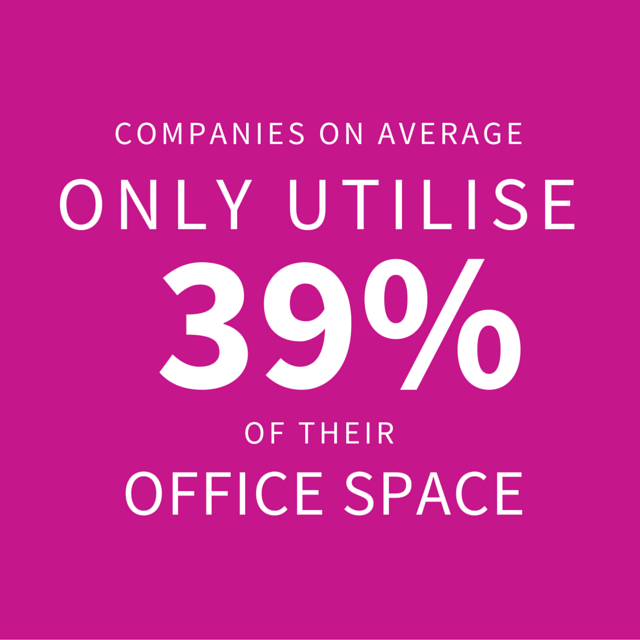Businesses are quickly becoming aware of the benefits that improved space utilisation holds. Corporate real estate prices are on the up so many organisations are starting to ask questions about their space utilisation in an attempt to reduce costs and effectively use existing space.
 Making more efficient use of workspace will not only have financial benefits, but also improve the working culture and increase performance. However, most organisations tend to be unaware of their lack of office utilisation and the truth can often come as a shock. Condeco workspace occupancy studies revealed that most workspaces are utilized around 39% on average. Barclays for instance found through Condeco Software that 20% of their desks were unused at any given time. They also discovered 20-30% of meeting room bookings were in fact no-shows, meaning no one was showing up for 3 out of 10 booked meetings.
Making more efficient use of workspace will not only have financial benefits, but also improve the working culture and increase performance. However, most organisations tend to be unaware of their lack of office utilisation and the truth can often come as a shock. Condeco workspace occupancy studies revealed that most workspaces are utilized around 39% on average. Barclays for instance found through Condeco Software that 20% of their desks were unused at any given time. They also discovered 20-30% of meeting room bookings were in fact no-shows, meaning no one was showing up for 3 out of 10 booked meetings.
Another blog that you may like to read: “Building flexibility.”
The potential savings from reducing this wastage and repurposing the space effectively is substantial. Workplace management technology can give an organisation a whole new perspective regarding their real estate by monitoring and measuring workspace in real-time. This helps organisations understand what facilities are being used and when – enabling effective workplace strategies to be developed.
Workplace flexibility
 Decreasing the number of desks isn’t the only way to improve your space usage. Consider how your office can be designed to support a better working culture with more flexibility. Offering a flexible environment has proven to result in happier employees and higher productivity levels. Letting people chose from a range of working locations and hours raises engagement and also builds trust. 53% of Canada’s workforce have flexible hours, raising engagement among these workers from 59% to 73%. Conversely, in the UK, 77% of workers feel “trapped” in their current role by the rigidity of working practices. Evolving traditional offices into more agile workplaces can shift a business from boring and restricting to exciting, dynamic places that encourage people to achieve their full potential.
Decreasing the number of desks isn’t the only way to improve your space usage. Consider how your office can be designed to support a better working culture with more flexibility. Offering a flexible environment has proven to result in happier employees and higher productivity levels. Letting people chose from a range of working locations and hours raises engagement and also builds trust. 53% of Canada’s workforce have flexible hours, raising engagement among these workers from 59% to 73%. Conversely, in the UK, 77% of workers feel “trapped” in their current role by the rigidity of working practices. Evolving traditional offices into more agile workplaces can shift a business from boring and restricting to exciting, dynamic places that encourage people to achieve their full potential.
Growing evidence suggests an agile workplace can can disrupt stagnant working habits, empower employees, increase productivity and reduce wasted time.
Attract the best talent
As working generations evolve, the need for agile working environments that are equipped for flexible working will only intensify. As more and more millennials join the workforce – flexibility will become more important for businesses to offer. By 2025, 75% of workers are predicted to be of the millennial generation and they are expected to demand greater flexibility at work.
A recent survey of HR professionals found that 92% believe employment flexibility will become the most important factor for job seekers. If a company wants to attract and retain the best talent, they must create an infrastructure for flexible working now.
Redesigning workspace is more than just saving rent and cutting costs. Developing agile offices will help increase employee productivity, encourage collaboration and attract the best people – giving a business competitive advantage.
Sources
http://calgaryherald.com/business/local-business/report-shows-flexible-work-options-leads-to-higher-employee-engagement
http://www.theguardian.com/women-in-leadership/2015/jul/06/presenteeism-over-productivity-why-flexible-working-needs-a-rebrand
http://www.iofficecorp.com/blog/12-mind-blowing-statistics-every-facilities-manager-should-know
http://www.capitaresourcing.co.uk/news-and-insight/knowledge-hub/workforce-horizons